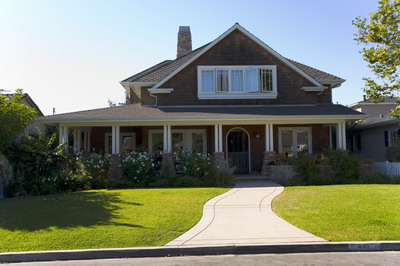 |

Roof trusses are one of the main structural components in residential and light-commercial structures.
A properly built roof truss is critical to the stability and longevity of your home. To do it properly you need a good stable design. It must be strong enough to withstand the expected dead loads (i.e. snow) and live loads (i.e. laborers).
For big commercial projects an engineer should handle the planning. For small home jobs an amateur could plan it out but an architect should probably look at it before it is built. Also, be sure your design is commensurate with the local building code before you begin.
Trusses are made from multiple straight members that form triangles whose ends are linked at joints called nodes. This allows them to span a wide space without using intermediate support. A triangle, one of the most basic geometric figures, is extremely stable and will not alter its form when the lengths of the sides are fixed. The triangles are formed by a lower chord, and two upper angled chords that match the roof line. Each truss should be equidistant from the other and dissect the frame in half at a 90 degree angle. This ensures all the trusses bear equal pressure. A roof, however, is only as strong as the weakest truss, and any truss is only as strong as the weakest connection or piece of material.
After the trusses are built and assembled the sheathing is then nailed to the narrow face of the truss top chord members. Not only is the roof sheathing used to cover the facility and carry imposed loads, but it also serves as a load-distributing element among trusses in the assembly. This construction characteristic causes the truss assembly to act as a system.
There are two common materials used for building trusses - wood and steel. Wood or sawn lumber is the most common material because it is cheap and sturdy. Lightweight steel has the advantage of being fire resistant. It also tougher and more durable than wood. On the other hand it is much more expensive. How much you use is also a determining factor of cost, but if you use too little your design might not be strong enough, so don't skimp on material. In many cases the roof will need to stand up to high winds and perhaps even hurricanes.
How high you make the trusses will be determined by whether you plan to include an attic - which is less common today.
A garden shed is the must have "accessory" for all home-owners. Easy to build, this is a simple weekend project for all do-it-yourselfers. Feel free to contact your local Roof 101 contractor for any further shed roof assistance or advice.

|
From residential to commercial roofing, we provide all roof installation and roof repair services for flat and sloped roofs.